Komponen: Konsep
Tetap teratur dengan koleksi
Simpan dan kategorikan konten berdasarkan preferensi Anda.
Elemen: Concept / info
| Namespace |
http://schemas.google.com/dspl/2010 |
| Anotasi |
Informasi tekstual, seperti nama dan deskripsi
konsepnya. |
| Diagram |
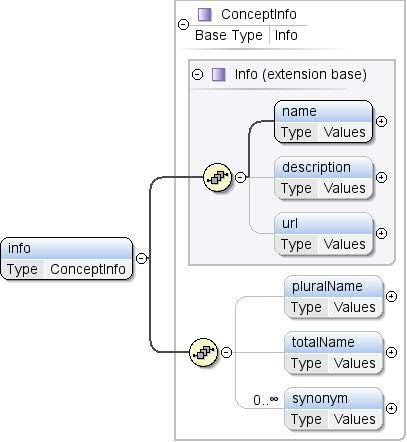 |
| Jenis |
ConceptInfo |
| Hierarki jenis |
|
| Properti |
|
| Model |
name , deskripsi{0,1} , url{0,1} , pluralName{0,1} , totalName{0,1} , sinonim* |
| Anak-Anak |
description, name, pluralName,
sinonim, totalName, url |
| Instance |
<info>
<name>{1,1}</name>
<description>{0,1}</description>
<url>{0,1}</url>
</info>
|
| Sumber |
<xs:element name="info" type="ConceptInfo">
<xs:annotation>
<xs:documentation>Textual information, such as the name and description of
the concept.</xs:documentation>
</xs:annotation>
</xs:element>
|
Elemen: Konsep / topik
| Namespace |
http://schemas.google.com/dspl/2010 |
| Anotasi |
Topik yang terkait dengan konsep. |
| Diagram |
 |
| Properti |
| konten: |
kompleks |
| minimum: |
0 |
| maxOccurs: |
tanpa batas |
|
| Atribut |
| QName |
Jenis |
Tetap |
Default |
Gunakan |
Annotation |
| referensi |
xs:QName |
|
|
opsional |
ID unik topik yang digunakan untuk konsep ini
yang terkait dengannya. Topik yang dirujuk dapat didefinisikan dalam
{i>dataset<i} atau secara eksternal, yaitu, dalam {i>dataset<i} lain. Referensi ke
topik eksternal harus dalam bentuk
"prefix:other_topic_id", dengan "prefix" adalah
yang digunakan untuk namespace set data eksternal (lihat XML
). |
|
| Sumber |
<xs:element name="topic" minOccurs="0" maxOccurs="unbounded">
<xs:annotation>
<xs:documentation>A topic the concept is associated with.</xs:documentation>
</xs:annotation>
<xs:complexType>
<xs:attribute name="ref" type="xs:QName">
<xs:annotation>
<xs:documentation>The unique identifier of the topic this concept is
associated with.
The referenced topic may be defined in the same
dataset or externally, i.e., in another dataset. A
reference to an external topic must be of the form
"prefix:other_topic_id", where "prefix" is the prefix
used for the namespace of the external dataset (see
XML namespaces).</xs:documentation>
</xs:annotation>
</xs:attribute>
</xs:complexType>
</xs:element>
|
Elemen: Concept / jenis
| Namespace |
http://schemas.google.com/dspl/2010 |
| Anotasi |
Jenis data konsep. Konsep harus memberikan jenis
deklarasi atau memperluas konsep lain. Dalam kasus di mana
memperluas konsep, maka juga dapat
memberikan deklarasi jenis. Jenis
konsep yang diperluas harus lebih longgar dibandingkan jenis
yang memperluasnya. "Kurang ketat dari" (LRT) adalah
urutan parsial yang didefinisikan sebagai berikut: string LRT float float bilangan bulat LRT
string tanggal LRT boolean |
| Diagram |
 |
| Properti |
| konten: |
kompleks |
| minimum: |
0 |
|
| Atribut |
|
| Sumber |
<xs:element name="type" minOccurs="0">
<xs:annotation>
<xs:documentation>The data type of the concept. A concept must provide a type declaration or extend
another concept. In the case where it's extending a concept, it may also
provide a type declaration. The type of the extended concept must be less restrictive
than the type of the concept extending it.
"Less restrictive than" (LRT) is a partial order defined as follows:
string LRT float
float LRT integer
string LRT date
string LRT boolean</xs:documentation>
</xs:annotation>
<xs:complexType>
<xs:attribute name="ref" type="DataType" use="required"/>
</xs:complexType>
</xs:element>
|
Elemen: Konsep / atribut
| Namespace |
http://schemas.google.com/dspl/2010 |
| Anotasi |
Atribut konsep. Atribut merepresentasikan tambahan
informasi tentang konsep (misalnya, PDB adalah persentase). |
| Diagram |
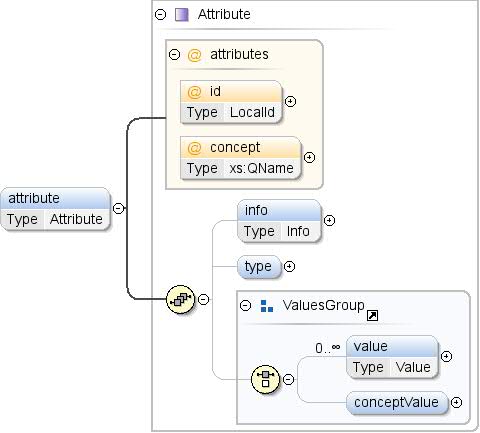 |
| Jenis |
Atribut |
| Properti |
| konten: |
kompleks |
| minimum: |
0 |
| maxOccurs: |
tanpa batas |
|
| Model |
info{0,1} , type{0,1} , (nilai*
| conceptValue{0,1}) |
| Anak-Anak |
conceptValue, info, type,
nilai |
| Instance |
<attribute concept="" id="">
<info>{0,1}</info>
<type format="" ref="">{0,1}</type>
</attribute>
|
| Atribut |
| QName |
Jenis |
Tetap |
Default |
Gunakan |
Annotation |
| konsep |
xs:QName |
|
|
opsional |
Referensi ke konsep yang sesuai dengan nilai-nilai
dari atribut. Jika atribut menentukan tipe, maka tipe
harus cocok dengan jenis konsep yang dirujuk. Referensi ke
konsep eksternal harus berbentuk
"prefix:other_Concept_id", dengan "prefix" bernilai
awalan yang digunakan untuk namespace set data eksternal (lihat XML
). |
| id |
LocalId |
|
|
opsional |
ID atribut konsep. Pengidentifikasi ini harus
unik di dalam konsep (di seluruh atribut dan properti). Tujuan
id dapat dihilangkan jika atribut konsep ditentukan. Di sana
kasus, id adalah implisit yang dibuat dengan nilai nama lokal
konsep yang direferensikan. Misalnya <attribute
concept="unit:currency"/> setara dengan
<attribute id="currency"
concept="unit:currency"/> |
|
| Sumber |
<xs:element name="attribute" type="Attribute" minOccurs="0" maxOccurs="unbounded">
<xs:annotation>
<xs:documentation>An attribute of the concept. Attributes represent additional
information about the concept (e.g., GDP is a percentage).</xs:documentation>
</xs:annotation>
</xs:element>
|
Elemen: Konsep / properti
| Namespace |
http://schemas.google.com/dspl/2010 |
| Anotasi |
Properti konsep. Properti merepresentasikan elemen
informasi tentang penerapan konsep (misalnya, konsep
"kota" dapat memiliki properti "country"). |
| Diagram |
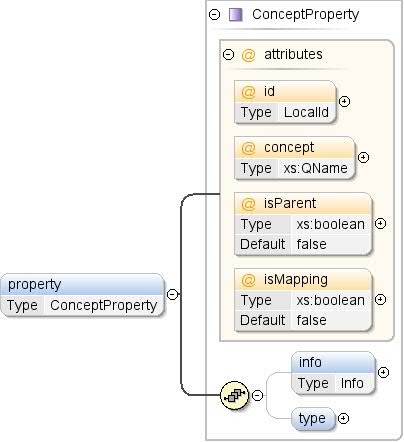 |
| Jenis |
ConceptProperty |
| Properti |
| konten: |
kompleks |
| minimum: |
0 |
| maxOccurs: |
tanpa batas |
|
| Model |
info{0,1} , jenis{0,1} |
| Anak-Anak |
info, jenis |
| Instance |
<property concept="" id="" isMapping="false" isParent="false">
<info>{0,1}</info>
<type ref="">{0,1}</type>
</property>
|
| Atribut |
| QName |
Jenis |
Tetap |
Default |
Gunakan |
Annotation |
| konsep |
xs:QName |
|
|
opsional |
Referensi ke konsep yang sesuai dengan nilai-nilai
dari properti. Jika properti menentukan tipe, maka tipe
harus cocok dengan jenis konsep yang dirujuk. Referensi ke
konsep eksternal harus berbentuk
"prefix:other_Concept_id", dengan "prefix" bernilai
awalan yang digunakan untuk namespace set data eksternal (lihat XML
). |
| id |
LocalId |
|
|
opsional |
ID properti konsep. Pengidentifikasi ini harus
unik di dalam konsep (di seluruh atribut dan properti). Tujuan
ID dapat dihilangkan jika properti konsep ditentukan. Di sana
secara implisit, id dibuat dengan nilai berupa nama lokal
konsep yang direferensikan. Misalnya <property
concept="geo:country"/> sama dengan <property
id="country"
concept="geo:country"/> |
| isMapping |
xs:boolean |
|
salah |
opsional |
Jika true (benar), properti ini harus merujuk ke sebuah konsep, dan
properti ini menunjukkan hubungan pemetaan (1-ke-1) antara
konsep dan konsep yang direferensikan. Setiap instance dari instance
konsep direferensikan oleh paling banyak
satu {i>instance <i}dari
konsep. |
| isParent |
xs:boolean |
|
salah |
opsional |
Jika true (benar), properti ini harus merujuk ke sebuah konsep, dan
properti ini menunjukkan hubungan hierarkis antara
konsep dan konsep yang dirujuk (mis., benua dari
negara). |
|
| Sumber |
<xs:element name="property" type="ConceptProperty" minOccurs="0" maxOccurs="unbounded">
<xs:annotation>
<xs:documentation>A property of the concept. Properties represent additional
information about instances of the concept (e.g., a concept
"city" may have a property "country").</xs:documentation>
</xs:annotation>
</xs:element>
|
Elemen: Concept / defaultValue
| Namespace |
http://schemas.google.com/dspl/2010 |
| Anotasi |
Nilai default untuk konsep, yang akan digunakan oleh aplikasi
ketika mereka perlu memilih salah satu nilai yang mungkin
konsepnya. |
| Diagram |
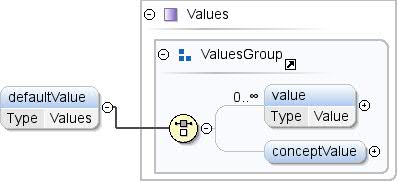 |
| Jenis |
Nilai |
| Properti |
| konten: |
kompleks |
| minimum: |
0 |
|
| Model |
value* | conceptValue{0,1} |
| Anak-Anak |
conceptValue, value |
| Instance |
<defaultValue>
<value lang="">{0,unbounded}</value>
<conceptValue concept="">{0,1}</conceptValue>
</defaultValue>
|
| Sumber |
<xs:element name="defaultValue" type="Values" minOccurs="0">
<xs:annotation>
<xs:documentation>A default value for the concept, to be used by
applications when they need to pick one of the possible
values of the concept.</xs:documentation>
</xs:annotation>
</xs:element>
|
Elemen: Konsep / tabel
| Namespace |
http://schemas.google.com/dspl/2010 |
| Anotasi |
Referensi ke tabel yang berisi semua nilai yang mungkin
untuk konsep dan properti non-konstannya. |
| Diagram |
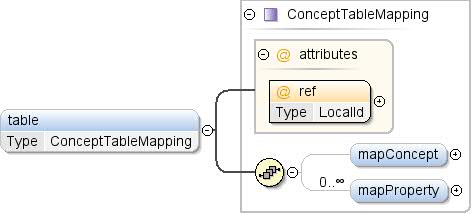 |
| Jenis |
ConceptTableMapping |
| Properti |
| konten: |
kompleks |
| minimum: |
0 |
|
| Model |
mapConcept{0,1} , mapProperty* |
| Anak-Anak |
mapConcept, mapProperty |
| Instance |
<table ref="">
<mapConcept toColumn="">{0,1}</mapConcept>
<mapProperty lang="" ref="" toColumn="">{0,unbounded}</mapProperty>
</table>
|
| Atribut |
| QName |
Jenis |
Tetap |
Default |
Gunakan |
Annotation |
| referensi |
LocalId |
|
|
wajib diisi |
ID tabel yang berisi data untuk
konsepnya. |
|
| Sumber |
<xs:element name="table" type="ConceptTableMapping" minOccurs="0">
<xs:annotation>
<xs:documentation>A reference to a table that contains all the
possible values for the concept and its non-constant
properties.</xs:documentation>
</xs:annotation>
</xs:element>
|
Tipe Kompleks: Konsep
| Namespace |
http://schemas.google.com/dspl/2010 |
| Anotasi |
Konsep adalah definisi jenis data yang muncul di
set data (mis., "PDB" atau "County"). Sebuah konsep dapat berupa
terkait dengan enumerasi
semua nilai yang mungkin atau tidak. J
yang ditentukan dalam beberapa {i>dataset<i} dapat dirujuk di {i>dataset<i} lainnya
set data. |
| Diagram |
 |
| Digunakan oleh |
|
| Model |
info , topik* , jenis{0,1} ,
attribute* , properti* , defaultValue{0,1} , tabel{0,1} |
| Anak-Anak |
attribute, defaultValue, info,
properti, tabel, topik,
jenis |
| Atribut |
| QName |
Jenis |
Tetap |
Default |
Gunakan |
Annotation |
| memperluas |
xs:QName |
|
|
opsional |
ID unik suatu konsep yang tidak diketahui oleh konsep ini
akan meluas. Konsep yang direferensikan dapat didefinisikan dalam {i>dataset<i} yang sama
atau secara eksternal, yaitu dalam {i>dataset <i}lain. Referensi ke eksternal
konsep harus berupa "prefix:other_konsep_id",
dengan "awalan" adalah awalan yang digunakan untuk namespace
set data eksternal (lihat namespace XML). |
| id |
ID |
|
|
wajib diisi |
ID unik konsep, yang harus
unik secara global dalam set data. |
|
| Sumber |
<xs:complexType name="Concept">
<xs:annotation>
<xs:documentation>A concept is a definition of a type of data that appears in the
dataset (e.g., "GDP" or "County"). A concept may be associated with
an enumeration of all its possible values or not. A concept defined in
some dataset may be referenced in other datasets.</xs:documentation>
</xs:annotation>
<xs:sequence>
<xs:element name="info" type="ConceptInfo">
<xs:annotation>
<xs:documentation>Textual information, such as the name and description of
the concept.</xs:documentation>
</xs:annotation>
</xs:element>
<xs:element name="topic" minOccurs="0" maxOccurs="unbounded">
<xs:annotation>
<xs:documentation>A topic the concept is associated with.</xs:documentation>
</xs:annotation>
<xs:complexType>
<xs:attribute name="ref" type="xs:QName">
<xs:annotation>
<xs:documentation>The unique identifier of the topic this concept is
associated with.
The referenced topic may be defined in the same
dataset or externally, i.e., in another dataset. A
reference to an external topic must be of the form
"prefix:other_topic_id", where "prefix" is the prefix
used for the namespace of the external dataset (see
XML namespaces).</xs:documentation>
</xs:annotation>
</xs:attribute>
</xs:complexType>
</xs:element>
<xs:element name="type" minOccurs="0">
<xs:annotation>
<xs:documentation>The data type of the concept. A concept must provide a type declaration or extend
another concept. In the case where it's extending a concept, it may also
provide a type declaration. The type of the extended concept must be less restrictive
than the type of the concept extending it.
"Less restrictive than" (LRT) is a partial order defined as follows:
string LRT float
float LRT integer
string LRT date
string LRT boolean</xs:documentation>
</xs:annotation>
<xs:complexType>
<xs:attribute name="ref" type="DataType" use="required"/>
</xs:complexType>
</xs:element>
<xs:element name="attribute" type="Attribute" minOccurs="0" maxOccurs="unbounded">
<xs:annotation>
<xs:documentation>An attribute of the concept. Attributes represent additional
information about the concept (e.g., GDP is a percentage).</xs:documentation>
</xs:annotation>
</xs:element>
<xs:element name="property" type="ConceptProperty" minOccurs="0" maxOccurs="unbounded">
<xs:annotation>
<xs:documentation>A property of the concept. Properties represent additional
information about instances of the concept (e.g., a concept
"city" may have a property "country").</xs:documentation>
</xs:annotation>
</xs:element>
<xs:element name="defaultValue" type="Values" minOccurs="0">
<xs:annotation>
<xs:documentation>A default value for the concept, to be used by
applications when they need to pick one of the possible
values of the concept.</xs:documentation>
</xs:annotation>
</xs:element>
<xs:element name="table" type="ConceptTableMapping" minOccurs="0">
<xs:annotation>
<xs:documentation>A reference to a table that contains all the
possible values for the concept and its non-constant
properties.</xs:documentation>
</xs:annotation>
</xs:element>
</xs:sequence>
<xs:attribute name="id" type="Id" use="required">
<xs:annotation>
<xs:documentation>The unique identifier of the concept, which must be globally
unique within the dataset.</xs:documentation>
</xs:annotation>
</xs:attribute>
<xs:attribute name="extends" type="xs:QName" use="optional">
<xs:annotation>
<xs:documentation>The unique identifier of a concept that this
concept extends.
The referenced concept may be defined in the same
dataset or externally, i.e., in another dataset. A
reference to an external concept must be of the form
"prefix:other_concept_id", where "prefix" is the
prefix used for the namespace of the external
dataset (see XML namespaces).</xs:documentation>
</xs:annotation>
</xs:attribute>
</xs:complexType>
|
| Namespace |
Tidak ada namespace |
| Anotasi |
ID unik topik yang dikaitkan dengan konsep ini
kami. Topik yang dirujuk dapat didefinisikan
dalam {i>dataset<i} yang sama atau
secara eksternal, yaitu dalam {i>dataset<i} lain. Referensi ke topik eksternal
harus dalam bentuk "prefix:other_topic_id", dengan
"awalan" adalah awalan yang digunakan untuk namespace eksternal
set data (lihat namespace XML). |
| Jenis |
xs:QName |
| Properti |
|
| Digunakan oleh |
|
| Sumber |
<xs:attribute name="ref" type="xs:QName">
<xs:annotation>
<xs:documentation>The unique identifier of the topic this concept is
associated with.
The referenced topic may be defined in the same
dataset or externally, i.e., in another dataset. A
reference to an external topic must be of the form
"prefix:other_topic_id", where "prefix" is the prefix
used for the namespace of the external dataset (see
XML namespaces).</xs:documentation>
</xs:annotation>
</xs:attribute>
|
| Namespace |
Tidak ada namespace |
| Jenis |
DataType |
| Properti |
|
| {i>Facet<i} |
| enumerasi |
string |
|
| enumerasi |
float |
|
| enumerasi |
bilangan bulat |
|
| enumerasi |
boolean |
|
| enumerasi |
tanggal |
|
| enumerasi |
konsep |
|
|
| Digunakan oleh |
|
| Sumber |
<xs:attribute name="ref" type="DataType" use="required"/>
|
Atribut: Concept / @id
| Namespace |
Tidak ada namespace |
| Anotasi |
ID unik konsep, yang harus ada secara global
unik dalam set data. |
| Jenis |
ID |
| Properti |
|
| {i>Facet<i} |
|
| Digunakan oleh |
|
| Sumber |
<xs:attribute name="id" type="Id" use="required">
<xs:annotation>
<xs:documentation>The unique identifier of the concept, which must be globally
unique within the dataset.</xs:documentation>
</xs:annotation>
</xs:attribute>
|
Atribut: Concept / @extends
| Namespace |
Tidak ada namespace |
| Anotasi |
ID unik dari konsep yang diperluas oleh konsep ini.
Konsep yang dirujuk dapat didefinisikan dalam
{i>dataset<i} yang sama atau secara eksternal,
yaitu, dalam {i>dataset<i} lain. Referensi ke konsep eksternal harus berupa
bentuk "prefix:other_Concept_id", dengan "prefix" bernilai
awalan yang digunakan untuk namespace set data eksternal (lihat XML
). |
| Jenis |
xs:QName |
| Properti |
|
| Digunakan oleh |
|
| Sumber |
<xs:attribute name="extends" type="xs:QName" use="optional">
<xs:annotation>
<xs:documentation>The unique identifier of a concept that this
concept extends.
The referenced concept may be defined in the same
dataset or externally, i.e., in another dataset. A
reference to an external concept must be of the form
"prefix:other_concept_id", where "prefix" is the
prefix used for the namespace of the external
dataset (see XML namespaces).</xs:documentation>
</xs:annotation>
</xs:attribute>
|
Dibuat menggunakan
Editor XML Oksigen.
Kecuali dinyatakan lain, konten di halaman ini dilisensikan berdasarkan Lisensi Creative Commons Attribution 4.0, sedangkan contoh kode dilisensikan berdasarkan Lisensi Apache 2.0. Untuk mengetahui informasi selengkapnya, lihat Kebijakan Situs Google Developers. Java adalah merek dagang terdaftar dari Oracle dan/atau afiliasinya.
Terakhir diperbarui pada 2025-07-25 UTC.
[[["Mudah dipahami","easyToUnderstand","thumb-up"],["Memecahkan masalah saya","solvedMyProblem","thumb-up"],["Lainnya","otherUp","thumb-up"]],[["Informasi yang saya butuhkan tidak ada","missingTheInformationINeed","thumb-down"],["Terlalu rumit/langkahnya terlalu banyak","tooComplicatedTooManySteps","thumb-down"],["Sudah usang","outOfDate","thumb-down"],["Masalah terjemahan","translationIssue","thumb-down"],["Masalah kode / contoh","samplesCodeIssue","thumb-down"],["Lainnya","otherDown","thumb-down"]],["Terakhir diperbarui pada 2025-07-25 UTC."],[],["Concepts, within a dataset (namespace: `http://schemas.google.com/dspl/2010`), define data types and are globally unique. Concepts can extend others, using `prefix:other_concept_id` for external references. They include `info` (textual details), `topic` (associated topics via `ref`), `type` (data type, `ref`), `attribute` (additional information), `property` (instance information), `defaultValue`, and `table` (data source, `ref`). Key concept attributes are `id` (unique), and `extends` (referencing another concept). External references are in `prefix:identifier` format. A concept must have a `type` or `extends`.\n"]]








